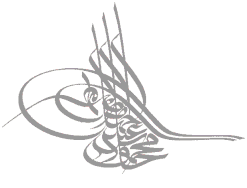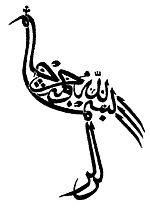
Islamic calligraphy, equally known as Arabic calligraphy, is the art of writing, and by extension, of bookmaking.[1] This art has most often employed the Arabic script, throughout many languages. Calligraphy is especially revered among Islamic arts since it was the primary means for the preservation of the Qur'an.
Throughout Islamic history, the work of calligraphers was collected and appreciated. Consideration of figurative art as idolatrous led to calligraphy and abstract figures becoming the main forms of artistic expression in Islamic cultures.[2]
Arabic, Persian and Ottoman Turkish calligraphy is associated with geometric Islamic art (the Arabesque) on the walls and ceilings of mosques as well as on the page. Contemporary artists in the Islamic world draw on the heritage of calligraphy to use calligraphic inscriptions or abstractions in their work.
Contents[hide] |
Role in Islamic culture
Calligraphy has arguably become the most venerated form of Islamic art because it provides a link between the languages of the Muslims with the religion of Islam. The holy book of Islam, the Qur'an, has played an important role in the development and evolution of the Arabic language, and by extension, calligraphy in the Arabic alphabet. Proverbs and complete passages from the Qur'an are still active sources for Islamic calligraphy. The Arabic alphabet consists of 28 letters and 18 different forms of writing.

Calligraphic scripts

The first Arabic script to gain popularity was the Kufic script, which was created in 537. Kufic is angular, made of square and short horizontal strokes, long verticals, and bold, compact circles. It was the main script used to copy the Qur'an for three centuries. Its static aspect made it suitable for monumental inscriptions, too. It developed many serifs (small decorations added to each character).
More often used for casual writing was the cursive Naskh script, with rounder letters and thin lines. As techniques for writing in this style were refined, it came to be preferred to Kufic for copying the Qur'an. Naskh is the first script taught to most children. Almost all printed material in Arabic is in Naskh so, to avoid confusion, children are taught to write in the same script. It is also clearer and easier to decipher.
In the 13th century, the Thuluth script took on the ornamental role formerly associated with the Kufic script. Thuluth means "one third"; the form of Thuluth is based on the principle that one third of each letter slides downward. Thus it has a strong cursive aspect and is usually written in ample curves.
After Persia was conquered by Arabs in the 7th century, it became common to write Persian in Arabic script. The Persians contributed the Ta'liq and Nasta'liq styles to Arabic calligraphy. Nasta'liq is extremely cursive, with exaggeratedly long horizontal strokes. One of its peculiarities is that vertical strokes lean to the right rather than (as more commonly) to the left, making Nasta'liq writing flow particularly well. The Persians also developed a style called shekasteh ('broken' in Persian). Shekasteh has seldom been used for scripting Arabic texts, though it is an Arabic calligraphy style.
The Diwani script is a cursive style of Arabic calligraphy developed during the reign of the early Ottoman Turks (16th and early 17th centuries). It was invented by Housam Roumi and reached its height of popularity under Süleyman I the Magnificent (1520–66). As decorative as it was communicative, Diwani was distinguished by the complexity of the line within the letter and the close juxtaposition of the letters within the word.
A variation of the Diwani, the Diwani Al Jali, is characterized by its abundance of diacritical and ornamental marks.

Finally, the most common script for everyday use is Ruq'ah (also known as Riq'a). Simple and easy to write, its movements are small, without much amplitude. It is the one most commonly seen. It is considered a step up from Naskh script, which children are taught first. In later grades they are introduced to Ruq'ah.
In China, a calligraphic form called Sini has been developed. This form has evident influences from Chinese calligraphy, using a horsehair brush as opposed to the standard reed pen. A famous modern calligrapher in this tradition is Hajji Noor Deen Mi Guangjiang [1].

Calligrams
Calligraphy, the most Islamic of arts in the Muslim world, has also its figurative sides. By interweaving written words, made from an "Allah", a "Muhammad", a "Bismillah", etc., or using micrography[3], calligraphers produced anthropomorphic figures ('Ali, the Ideal Human of mystics, a praying man[4], a face), zoomorphisms (symbolical creatures, most from the Shi'a iconography, like the lion (Duldul, horse of 'Ali[5], horse ('Ali's Duldul)[6], fish[3], stork[7] or other bird (the qur'anic Hudhud)[8][9]) and unanimated representations (a sword (Dhu al-Fiqar), a mosque, a ship (made from the letter and Arabic grammatical conjunction waw, symbol of mystical union)). Calligrams are related to Muslim mysticism and popular with many leading calligraphers in Turkey, Persia and India from the 17th century onward.
In the teachings of calligraphy figurative imagery is used to help visualize the shape of letters to trace (such as "initial ha' looks in nasta'liq similar to two eyes like his Persian name implies: "ha' two eyes" he' do tcheshm). In literature and poetry seeing in letters a reflection of the natural world goes back to the Abbasid times.
One of the contemporary masters of the calligram genre is Hassan Massoudy.
A good example is the logo of Al Jazeera, a local/international news station based at Qatar.
Instruments and media
The traditional instrument of the Arabic calligrapher is the qalam, a pen made of dried reed or bamboo; the ink is often in color, and chosen such that its intensity can vary greatly, so that the greater strokes of the compositions can be very dynamic in their effect.
A variety of media were employed for presenting calligraphy. Before the advent of paper, papyrus and parchment were used for writing. The advent of paper revolutionized calligraphy. While monasteries in Europe treasured a few dozen volumes, libraries in the Muslim world regularly contained hundreds and even thousands of volumes of books.[10]
Another medium for calligraphy were coins. Beginning in 692, the Islamic caliphate reformed the coinage of the Near East by replacing visual depiction by words. This was especially true for dinars, or gold coins of high value. Generally the coins were inscribed with quotes from the Qur'an.
By the tenth century, the Persians, who had converted to Islam, began weaving inscriptions on to elaborately patterned silks. So precious were calligraphic inscribed textile, that Crusaders brought them to Europe as prized possessions. A notable example is the Shroud of St. Josse, used to wrap the bones of St. Josse in the abbey of St. Josse-sur-Mer near Caen in northwestern France.[11]


![Example showing Nastaʿlīq's (Persian) proportion rules.[ 1 ]](http://upload.wikimedia.org/wikipedia/en/thumb/0/0c/Nastaliq-proportions.jpg/200px-Nastaliq-proportions.jpg)






1 comment:
i love it, thanks for sharing
Post a Comment